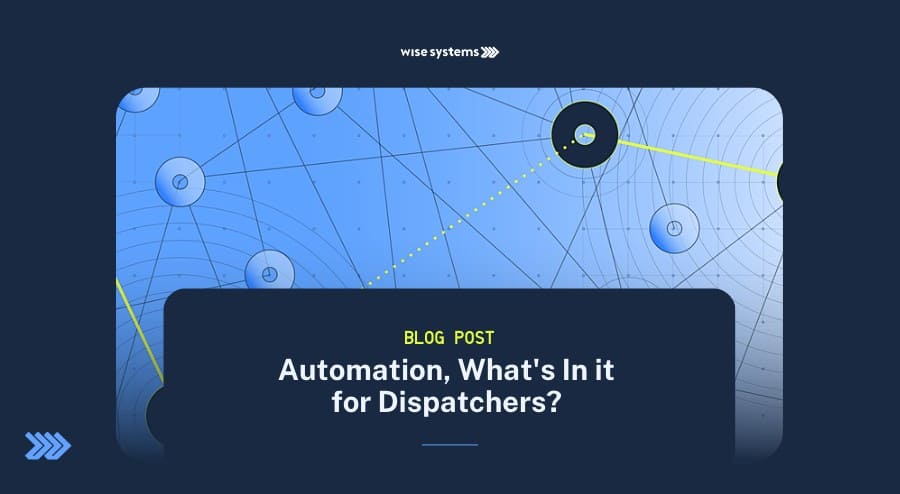Automation, What’s in It for Dispatchers?

Wise Systems

Have you ever wished for more hours in a day working as a delivery dispatcher or fleet manager? Between manually tracking down drivers, monitoring routes, and gathering up-to-date delivery information, spending so much time on labor-intensive processes can make you feel like you’re falling behind on the job. While you might not be able to change the number of hours in a day, you can better optimize your time and tasks using an automated routing and dispatching software solution.
Implementing an automated dispatch system can reduce dispatchers’ workloads, allowing them to use their valuable time to complete other vital tasks and focus on customer service. Beyond time saving, this software can drastically enhance your operation’s overall efficiency leading to
improved fleet utilization and streamlined planning processes.
In fact, automating even a few tasks such as stop sequencing, route optimization, and/or data collection can positively impact your people, processes, and performance. In this post, we’ll dive into all things automation, including:
- What an automated dispatch system is
- What tasks can be automated
- How automation frees dispatchers to focus on other tasks
- Benefits of using an automated dispatch system
What is an automated dispatch system?
An automated dispatch system is a software solution that automatically coordinates the movement of goods and services. Modern, web-based systems eliminate manual methods ( pen and paper) and legacy systems, as they’re able to monitor routes in real-time, optimize the end-to-end delivery process, and ultimately enhance the customer experience – all while cutting down on business costs. A common misconception is that automated systems replace dispatchers, but in reality, they’re a helpful tool that improves dispatchers’ day-to-day lives, and enabling them to focus on high-value activities.
What are the benefits of using an automated dispatch system?
Whether you’re focused on retail delivery or courier and parcel delivery services, every last-mile delivery business can benefit from automating dispatch processes. Here are a few of the key benefits to consider:
- Increased Dispatcher Efficiency and Productivity: By streamlining processes and reducing hours spent on manual labor, dispatchers can focus on the tasks that matter most, leading to greater output and overall efficiency.
- Reduced Errors and Improved Accuracy: Using powerful algorithms that manage large volumes of data and constraints, automation reduces mistakes and late arrivals, and offers more accurate, real-time results. This also takes the pressure off dispatchers to continuously track down updated information.
- Improved Fleet Utilization: With accurate data and the ability to leverage historical data for route planning, automated route planning solutions can increase fleet utilization to ensure the most efficient use of vehicles and drivers.
- Increased Job Satisfaction for Dispatchers: With automated dispatching and routing, dispatchers can focus on more complex and rewarding tasks, leading to improved engagement and job satisfaction.
- An Empowered Workforce: Training employees on new tools and technologies helps them perform their jobs more efficiently and provides them with the necessary skills to succeed in an ever-evolving logistics industry.
Which dispatcher tasks can be automated with software?
While not all dispatching tasks can be automated with software solutions, several important ones can be, including:
- Planning Routes: Automated systems sequence stops for efficiency and determine which drivers and vehicles will make a run. Further if there are vehicle or driver constraints, the system can automatically incorporate that information.
- Route Optimization: The system optimizes each route during planning and execution, applying additional customer, business, and physical constraints to planned routes to determine the most efficient routing while fitting into customer, employee, and team processes. It will also reroute vehicles (where allowed) to prevent or reduce delivery refusals.
- Data Collection: The system collects data throughout each shift to ensure accurate documentation and reporting.
- KPI Tracking: Ensure that established KPIs around on-time deliveries, driver utilization, and costs per shipment are met.
- Communication: Automated systems provide fleet-wide visibility so that drivers’ location, route progress, and delivery status are all visible.
What will dispatchers have more time to focus on?
By automating the above tasks, dispatchers have more time to focus on tasks that can’t be automated. Because of this, a dispatcher will have more time to tackle tasks like:
Scheduling drivers or operators based on shipment forecasts, availability, and skill levels
Booking loads
Managing: Data entry, Driver payroll, time and activity logging
Communicating with:
- Clients to take orders, book loads, solve customer issues, and ensure successful route execution.
- Drivers to provide support, troubleshoot navigation issues, offer suggestions on performance improvements, and ensure safety and successful route execution.
- Managers to provide updates on driving performance and coordinate optimal utilization of equipment.
- Independent owners, operators, and contractors
Report on:
- Assignment outcomes
- Service and performance issues
Ensure:
- Compliance with all regulatory and company health & safety policies
- The safe return of parcels and goods as a result of failed delivery
Get Real-Time Fleet Visibility and Control with Dispatcher from Wise Systems
Take the next step in modernizing your fleet management, and give time back to dispatchers with Dispatcher from Wise Systems. Dispatcher ensures more perfect stops by monitoring route execution in real-time, while allowing you to:
- Anticipate and respond quickly to any issues that may arise
- Maximize fleet efficiency
- Provide excellent customer service
Sound like something you’re interested in? Schedule a demo of Dispatcher today.





